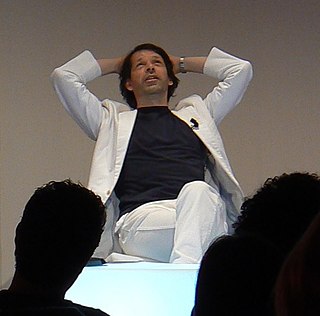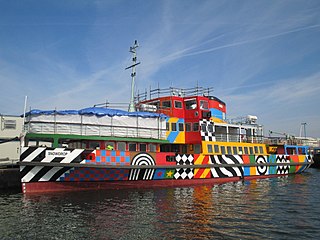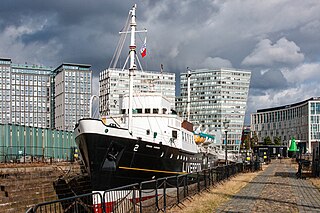
Vorticism was a London-based modernist art movement formed in 1914 by the writer and artist Wyndham Lewis. The movement was partially inspired by Cubism and was introduced to the public by means of the publication of the Vorticist manifesto in Blast magazine. Familiar forms of representational art were rejected in favour of a geometric style that tended towards a hard-edged abstraction. Lewis proved unable to harness the talents of his disparate group of avant-garde artists; however, for a brief period Vorticism proved to be an exciting intervention and an artistic riposte to Marinetti's Futurism and the post-impressionism of Roger Fry's Omega Workshops.

A dry dock is a narrow basin or vessel that can be flooded to allow a load to be floated in, then drained to allow that load to come to rest on a dry platform. Dry docks are used for the construction, maintenance, and repair of ships, boats, and other watercraft.

Arthur Lismer, LL.D. was an English-Canadian painter, member of the Group of Seven and educator. He is known primarily as a landscape painter and for his paintings of ships in dazzle camouflage.

Peter Andrew Saville is an English art director and graphic designer. He designed many record sleeves for Factory Records, which he co-founded in 1978 alongside Tony Wilson and Alan Erasmus.

Dazzle camouflage, also known as razzle dazzle or dazzle painting, is a family of ship camouflage that was used extensively in World War I, and to a lesser extent in World War II and afterwards. Credited to the British explorer Sir John Graham Kerr, it consisted of complex patterns of geometric shapes in contrasting colours interrupting and intersecting each other.

Edward Alexander Wadsworth was a British artist initially associated with the Vorticism movement. In the First World War he was part of a team involved in the transfer of dazzle camouflage designs to ships for the Royal Navy. After the war his maritime landscapes and still-life compositions using tempera were infused with a surrealistic mood - although he never exhibited with the British surrealists. In the early thirties and in the early forties his work was mainly abstract. He made a significant contribution to the development of modern art in Britain in the inter-war years.

Dazzle Ships is the fourth studio album by English electronic band Orchestral Manoeuvres in the Dark (OMD), released on 4 March 1983 by Virgin Records. Its title and cover art allude to a painting by Vorticist artist Edward Wadsworth based on dazzle camouflage, titled Dazzle-ships in Drydock at Liverpool.

The MV Vacationland is a Canadian RORO ferry that operated across the Northumberland Strait between the ports of Cape Tormentine, New Brunswick and Port Borden, Prince Edward Island.

Everett Longley Warner was an American Impressionist painter and printmaker, as well as a leading contributor to US Navy camouflage during both World Wars.

The Dazzle ships of the 14–18 NOW project are artworks created to commemorate the work of the artists and artisans who developed and designed the dazzle camouflage used in the First World War by ships as a defence against U-boat attack.

Norman Wilkinson was a British artist who usually worked in oils, watercolours and drypoint. He was primarily a marine painter, but also an illustrator, poster artist, and wartime camoufleur. Wilkinson invented dazzle painting to protect merchant shipping during the First World War.

Frederick Judd Waugh was an American artist, primarily known as a marine artist. During World War I, he designed ship camouflage for the U.S. Navy, under the direction of Everett L. Warner.

Solomon Joseph Solomon was a British painter, a founding member of the New English Art Club and member of the Royal Academy.

Maximilian Toch was an American paint manufacturer and industrial chemist who developed a concrete filler method that was used in the construction of the Panama Canal. He was the co-owner of the New York firms Toch Brothers and the Standard Varnish Works, where he was head of research and production. Before and during World War I, he was a major contributor to the development of ship camouflage in the United States, as well as an early practitioner of the use of chemistry in the authentication of works of art.

Leonard Campbell Taylor was a British painter, mainly of portraits and interiors in a traditional style. Among his patrons was the founding family of Courtaulds and the Courtauld Institute of Art. He was a member of the Royal Academy.

The Marine Museum of the Great Lakes is a museum dedicated to marine history in the Great Lakes. It is located at 55 Ontario St. in Kingston, Ontario, which is also a designated National Historic Site of Canada.
Dazzle camouflage of warships was adopted by the U.S. Navy during World War II, following research at the Naval Research Laboratory. Dazzle consists in painting obtrusive patterns on vertical surfaces. Unlike some other forms of camouflage, dazzle works not by offering concealment but by making it difficult to estimate a target's range, speed and heading. Each ship's dazzle pattern was unique to make it more difficult for the enemy to recognize different classes of ships. The result was that a profusion of dazzle schemes were tried, and the evidence for their success was at best mixed.
Victorine Anne Foot was a British artist who worked in oils, watercolours and pastels. Foot is best known for her work during World War II on military camouflage and for her post-war career as an artist and teacher in Scotland.

MV Edmund Gardner is a retired pilot cutter built for the Liverpool Pilot Service after the Second World War. She was decommissioned after nearly 30 years service converted to a museum ship as part of the Merseyside Maritime Museum.

















